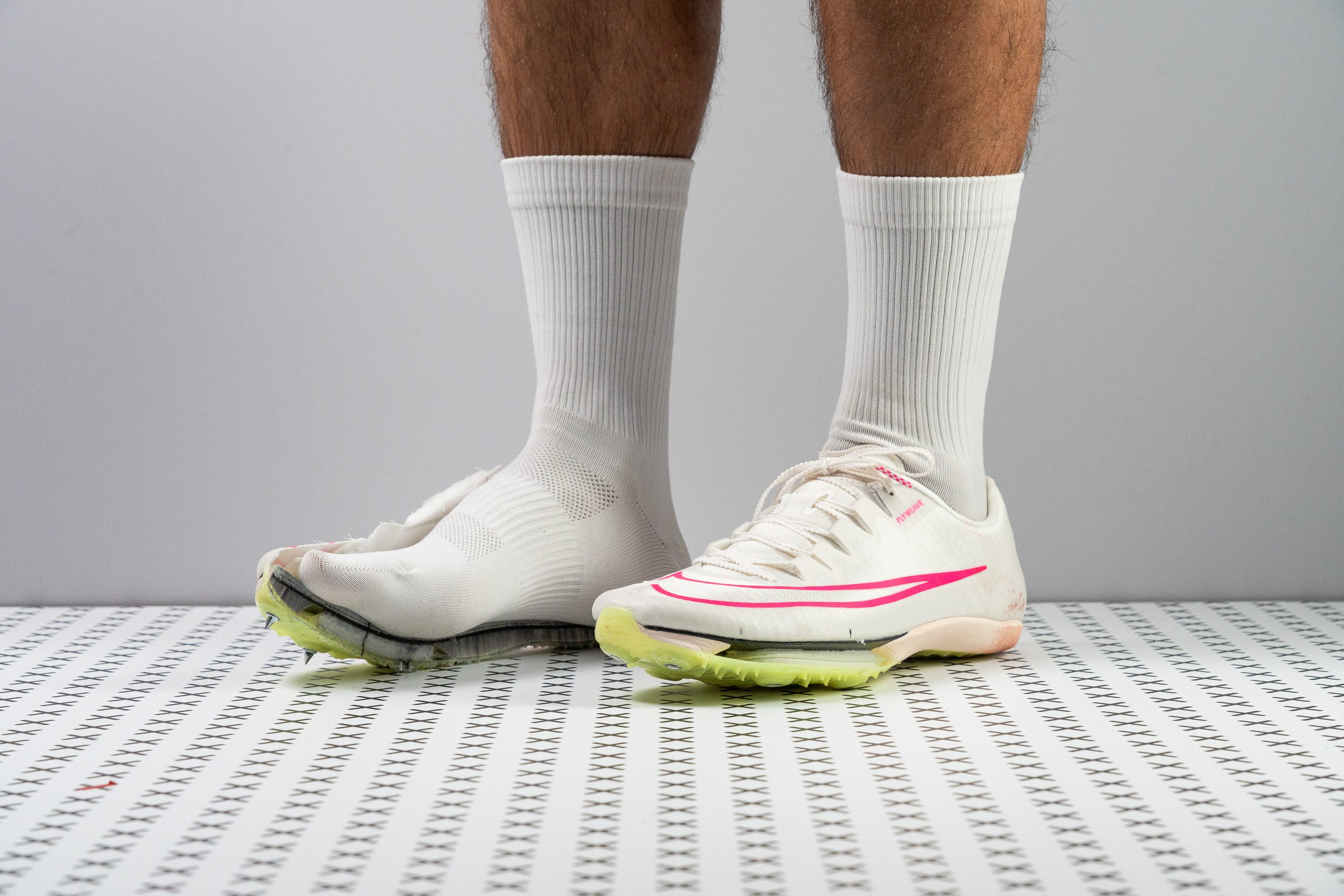Our verdict
Pros
- Extremely springy ride
- Snug, performance-oriented fit
- Propulsion from Flyplate and Zoom Air
- Premium design and materials
- Ideal for 100-400m sprints
- Can be used for hurdles
- Unmatched comfort and speed
- Notched laces for secure lockdown
Cons
- Expensive
- Requires some adaptation
- Can feel unstable for some
Audience verdict
Comparison
The most similar track spikes compared
+ + Add a shoe | |||||
|---|---|---|---|---|---|
| Audience score | 90 Great! | 94 Great! | 93 Great! | 90 Great! | |
| Price | $180 | $190 | $180 | $150 | |
| Weight lab | 6 oz / 169g | 6.4 oz / 181g | 6.5 oz / 183g | 5.5 oz / 156g | |
| Breathability | Moderate | Moderate | Breathable | Breathable | |
| Use | HurdlesSprints | Sprints | HurdlesSprints | HurdlesSprints | |
| Removable spikes | ✓ | ✓ | ✓ | ✓ | |
| Width / fit | Narrow | Medium | Medium | Medium | |
| Toebox width | Medium | Medium | Narrow | Medium | |
| Drop lab | -0.9 mm | -2.0 mm | -5.8 mm | 0.0 mm | |
| Size | Slightly small | True to size | True to size | Slightly small | |
| Midsole softness | Balanced | Balanced | Balanced | - | |
| Tongue padding | Thick | Thick | Thick | Average | |
| Stiffness | Stiff | Stiff | Stiff | Moderate | |
| Torsional rigidity | Stiff | Stiff | Stiff | Moderate | |
| Heel counter stiffness | Moderate | Moderate | Flexible | Flexible | |
| Outsole thickness | Average | Thin | Average | Very thick | |
| Heel tab | None | None | None | Finger loop | |
| Heel stack lab | 15.9 mm | 15.7 mm | 11.0 mm | 12.3 mm | |
| Forefoot | 16.8 mm | 17.7 mm | 16.8 mm | 12.3 mm | |
| Insole thickness | Average | Average | Average | Average | |
| Midsole width - forefoot | Average | Average | Very wide | Very narrow | |
| Midsole width - heel | Average | Wide | Average | Very narrow | |
| Ranking | #9 Bottom 30% | #4 Top 31% | #5 Top 39% | #7 Bottom 46% | |
| Popularity | #6 Top 47% | #1 Top 8% | #11 Bottom 15% | #4 Top 31% |
Who should buy
We think the Nike Air Zoom Maxfly is a must-have spike for those seeking:
- Explosive power and protection from the Air Zoom unit.
- Top-tier performance across sprints from 60m to 400m, with versatility extending all the way up to the 1500m for some.
- A supremely aggressive, stiff ride balanced with a certain degree of comfort.
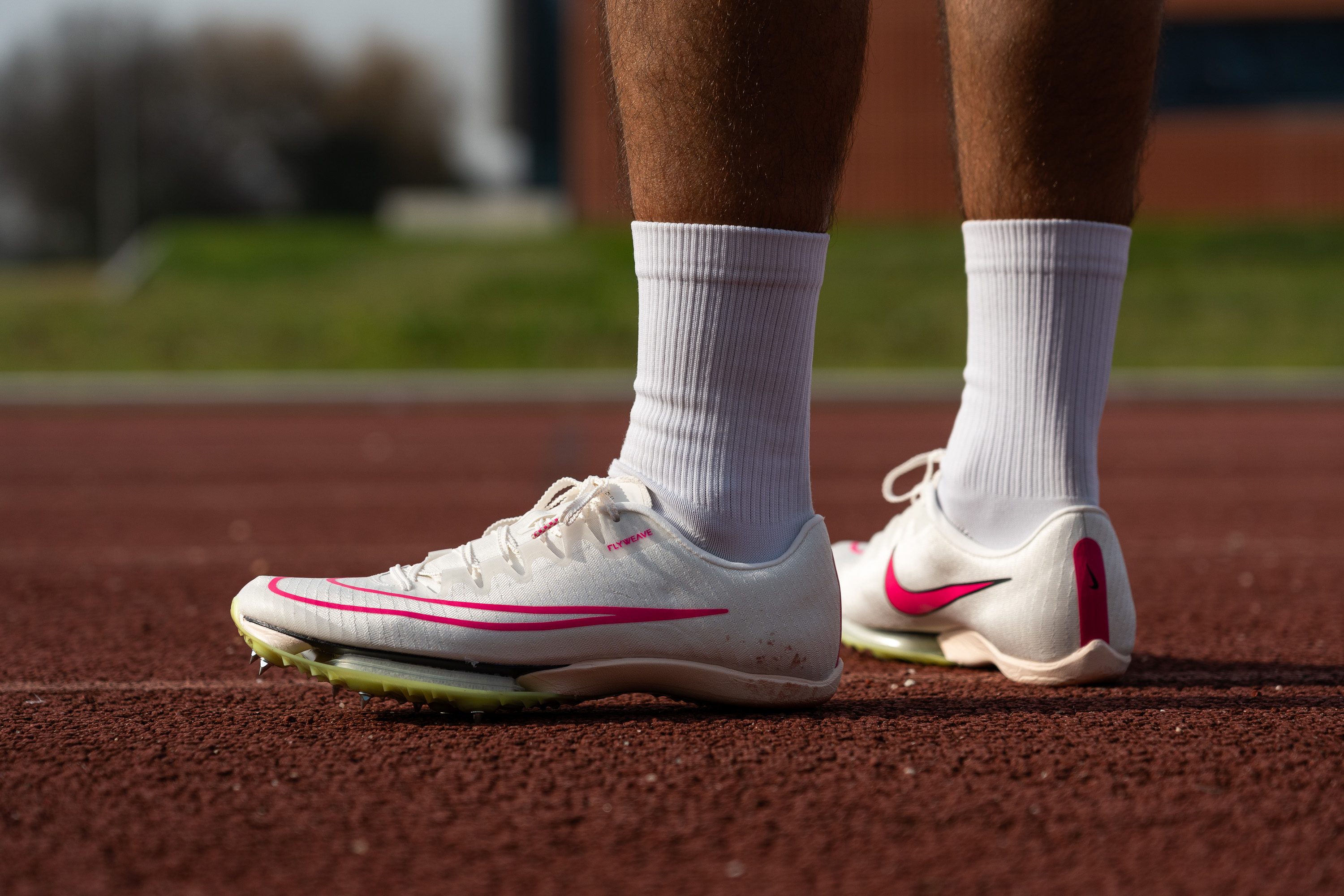
Who should NOT buy
While we appreciate the responsive Air Zoom unit in the Maxfly's forefoot, we recognize it won't suit everyone's preferences. Those craving a traditional, grounded ride might find a better fit in the Adidas Prime SP2.
We also don't recommend the Maxfly for distances beyond 800m. Its focus is clearly on shorter sprints. Instead, check out the versatile and budget-friendly Nike Zoom Rival D 10—its comfortable design could be a smarter choice for longer races especially if it's your first spike.
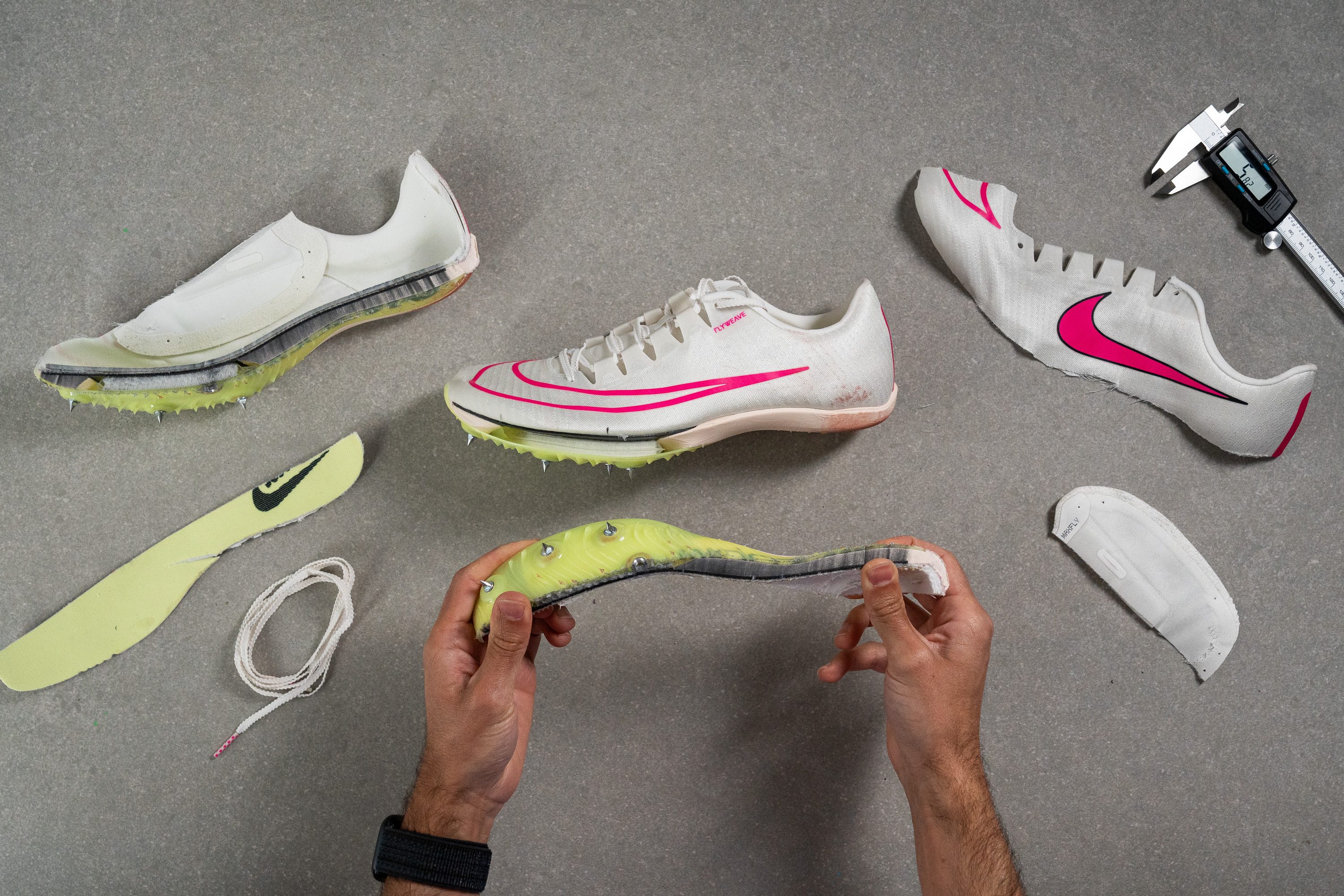
Cushioning
Heel stack
We measured a 15.9 mm heel stack, meeting current World Athletics regulations.
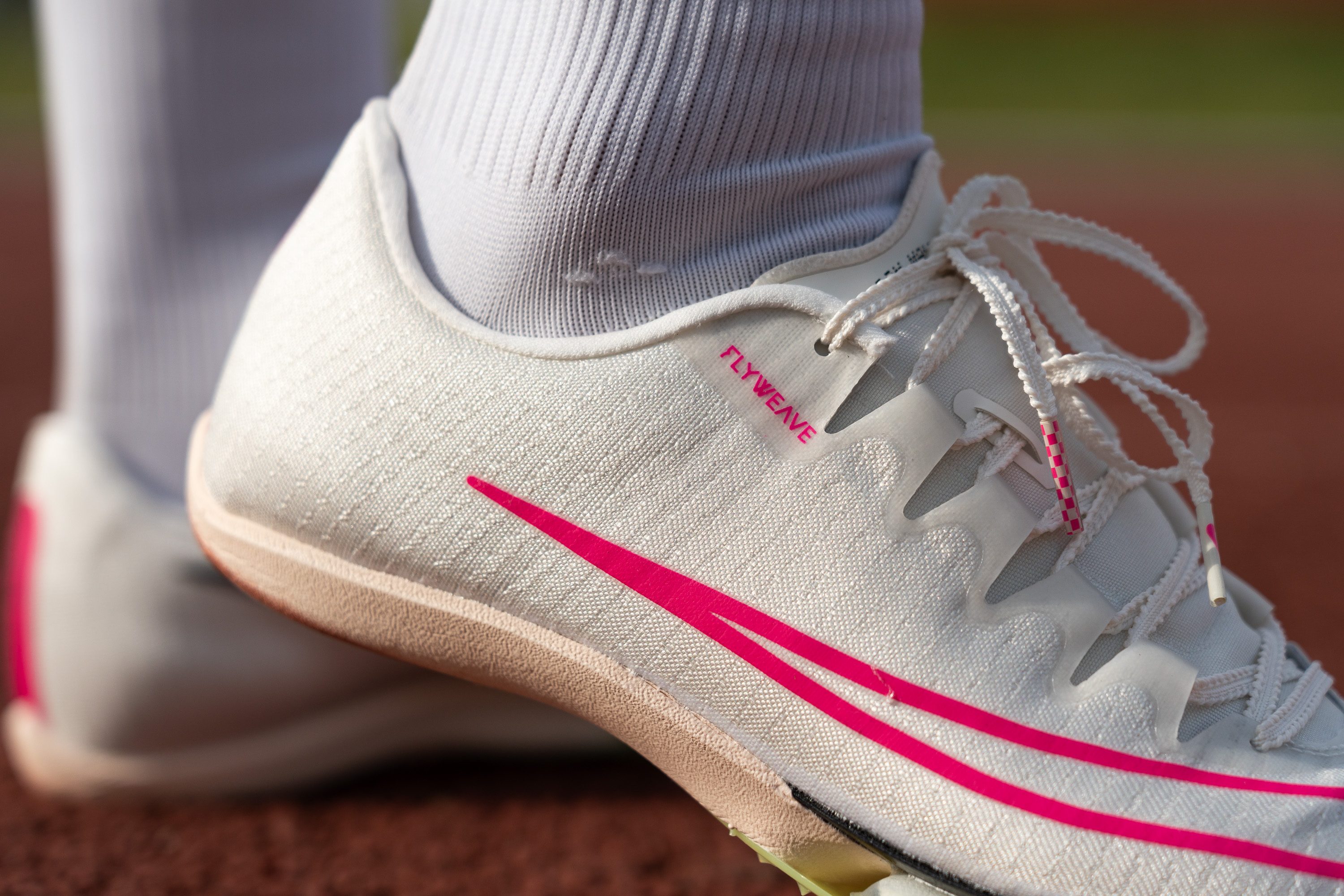
These guidelines will tighten in late 2024, limiting stack height to under 20 mm (at the time of this review, the limit is 25 mm).
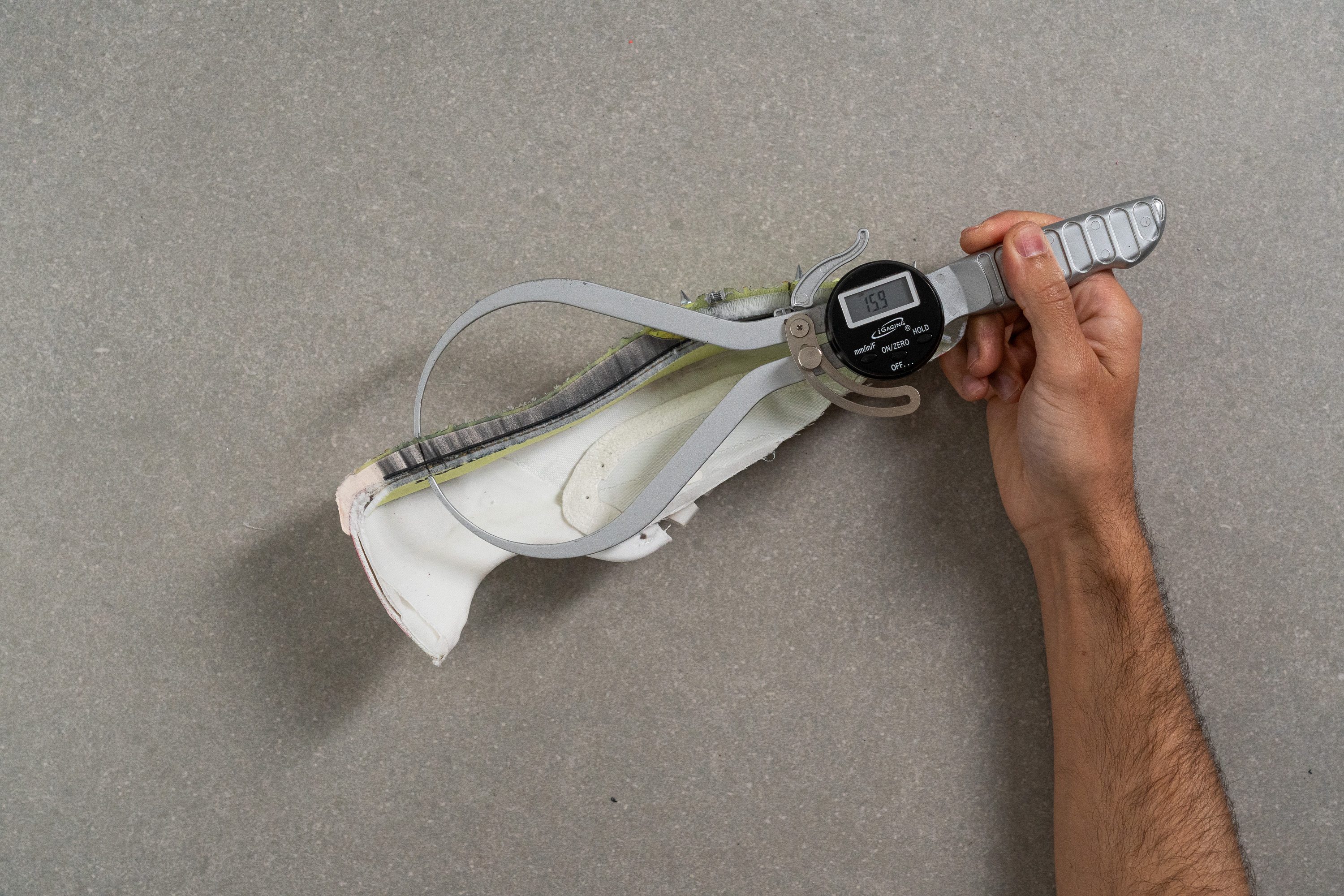
| Air Zoom Maxfly | 15.9 mm |
| Average | 15.8 mm |
Forefoot stack
We measured the forefoot at 16.8 mm, slightly higher than the heel. This strategic design maximizes forward propulsion by placing extra cushioning and responsiveness precisely where sprinters need it most, under the ball of the foot.
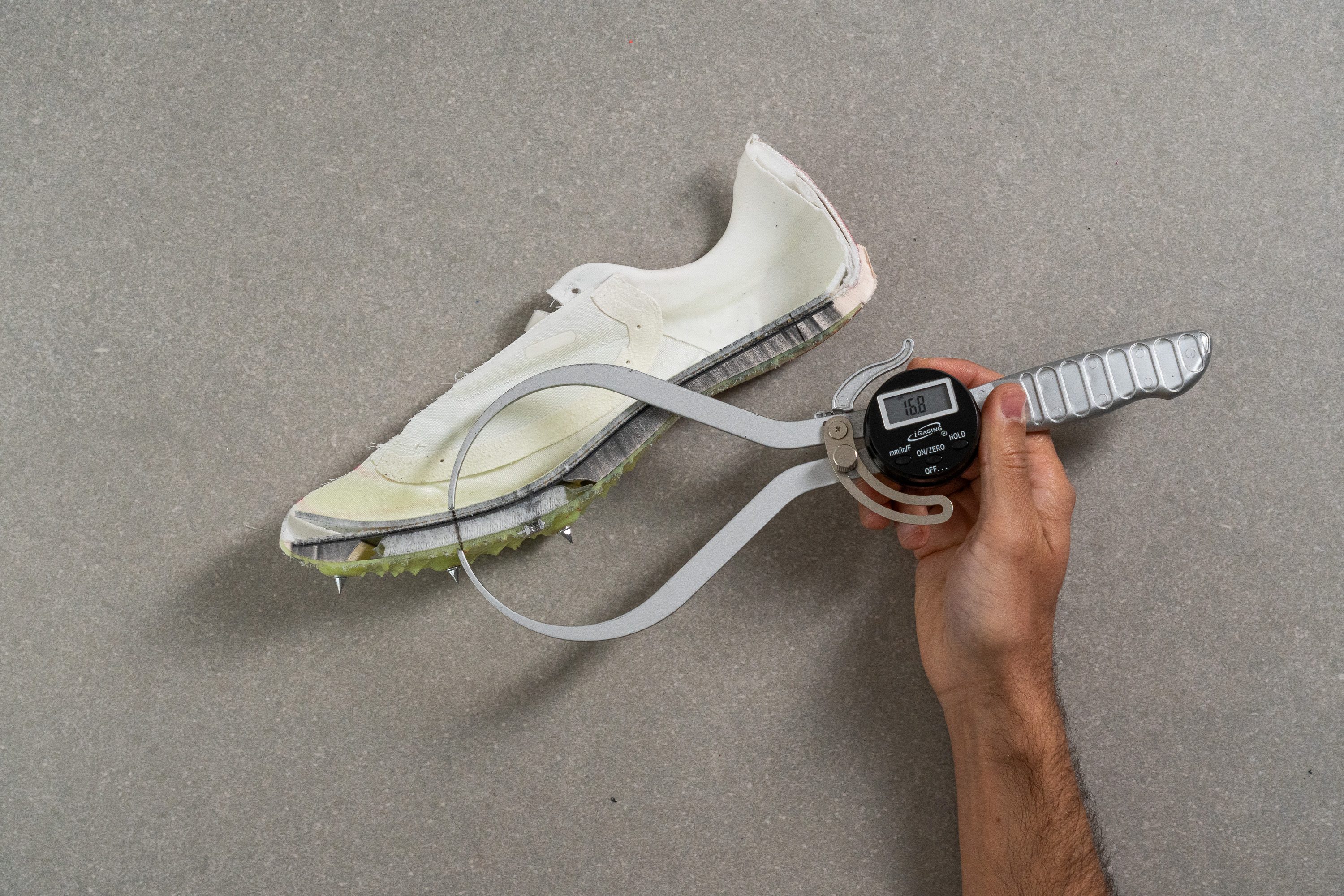
| Air Zoom Maxfly | 16.8 mm |
| Average | 14.8 mm |
Drop
The heel-to-forefoot difference creates a negative drop of -0.9 mm. While this might seem unusual for a traditional road shoe, we think it's an ideal design for elite-level spikes. This aggressive configuration promotes explosive propulsion for peak performance.
However, in our view, runners who are new to the world of spikes should exercise caution when first stepping into a shoe like the Maxfly. Ease into doing drills in them gradually to give your calves and Achilles tendons time to adjust and prevent injury.
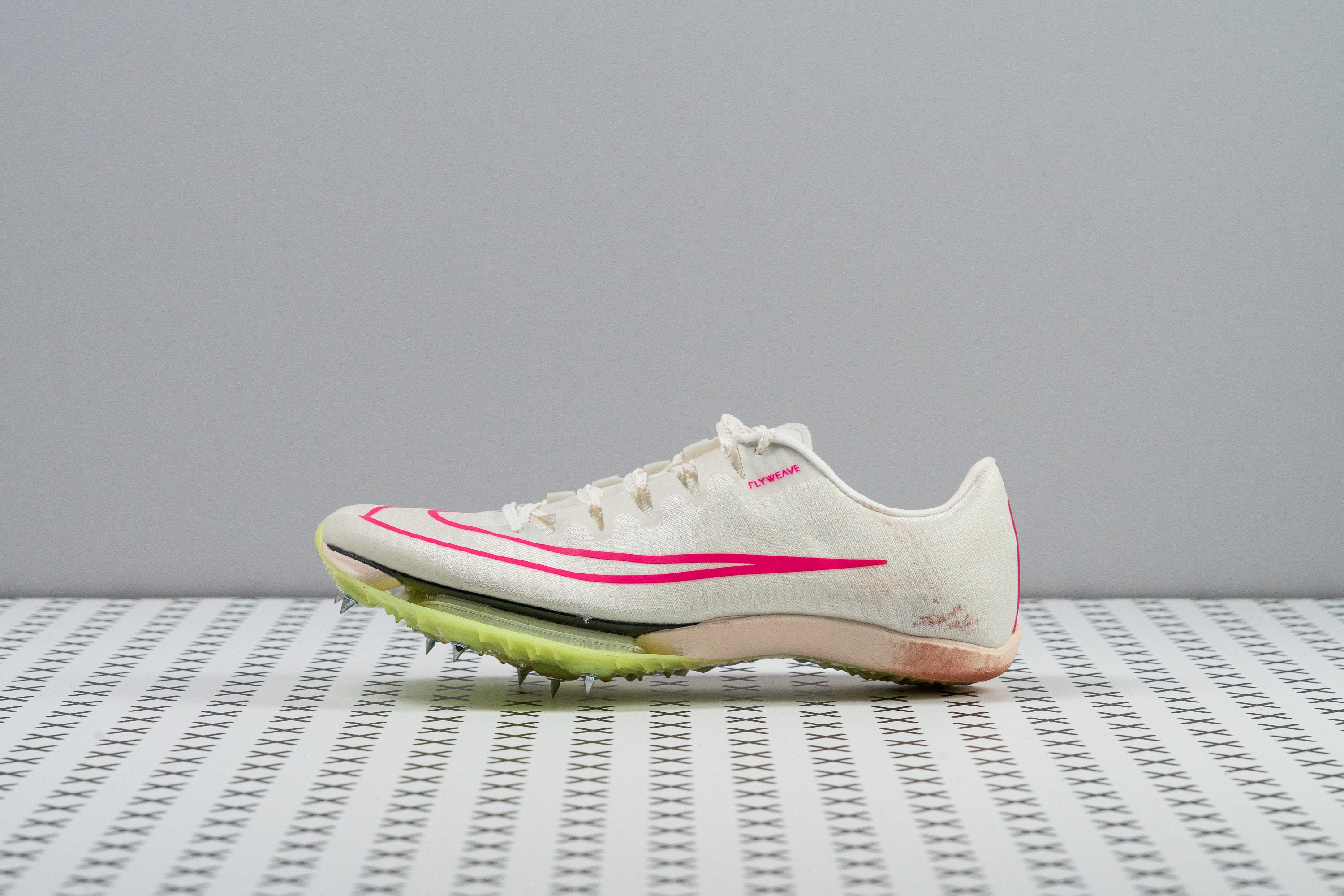
| Air Zoom Maxfly | -0.9 mm |
| Average | 1.0 mm |
Midsole softness
The Maxfly features Nike's top-tier ZoomX foam, identical to that found in their other top-performing racing shoes like the Alphafly 3.
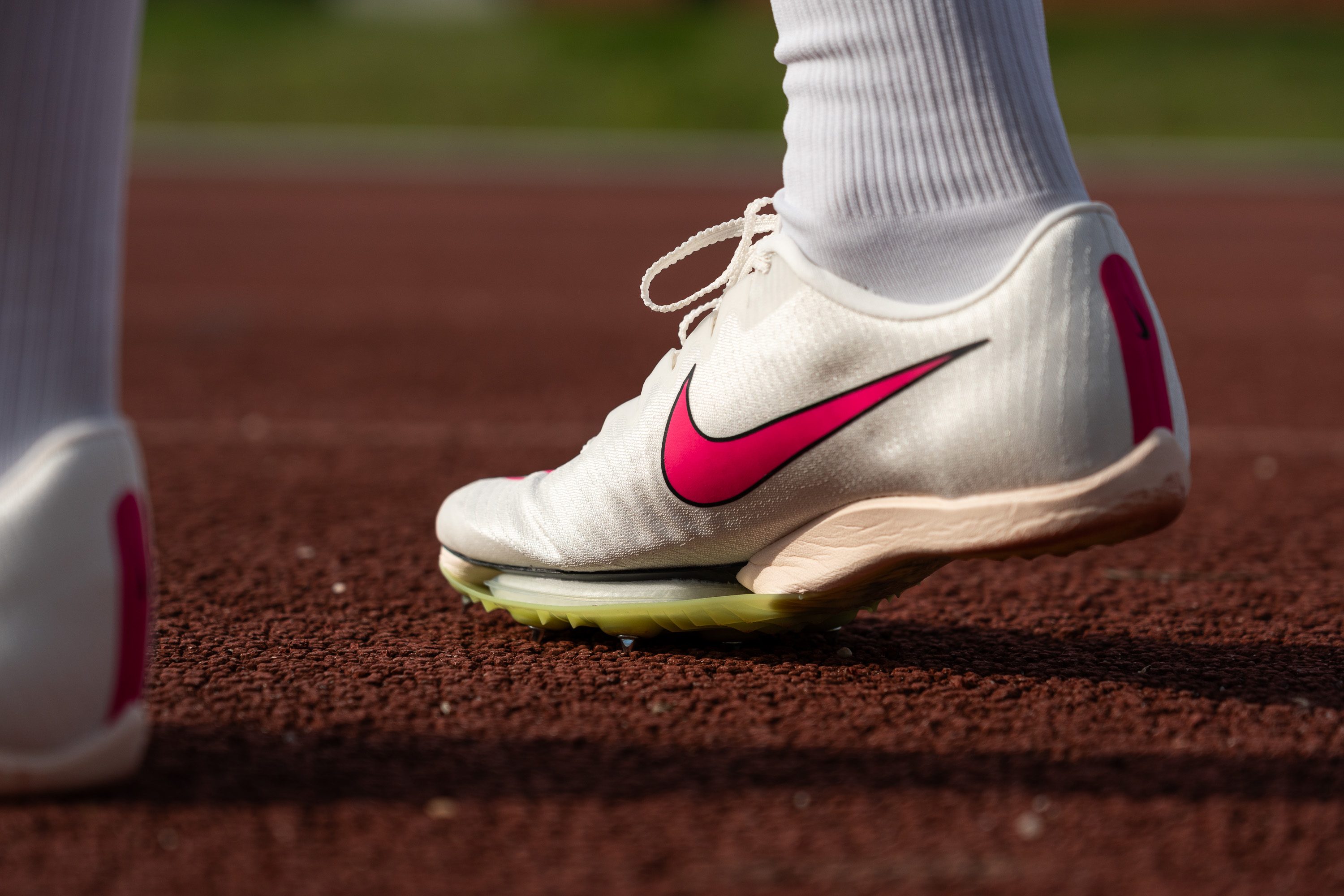
This specialized formulation boasts incredible density with a remarkably firm yet responsive feel (29.0 HA on our durometer test)—everything a competitor craves for explosive track performance.
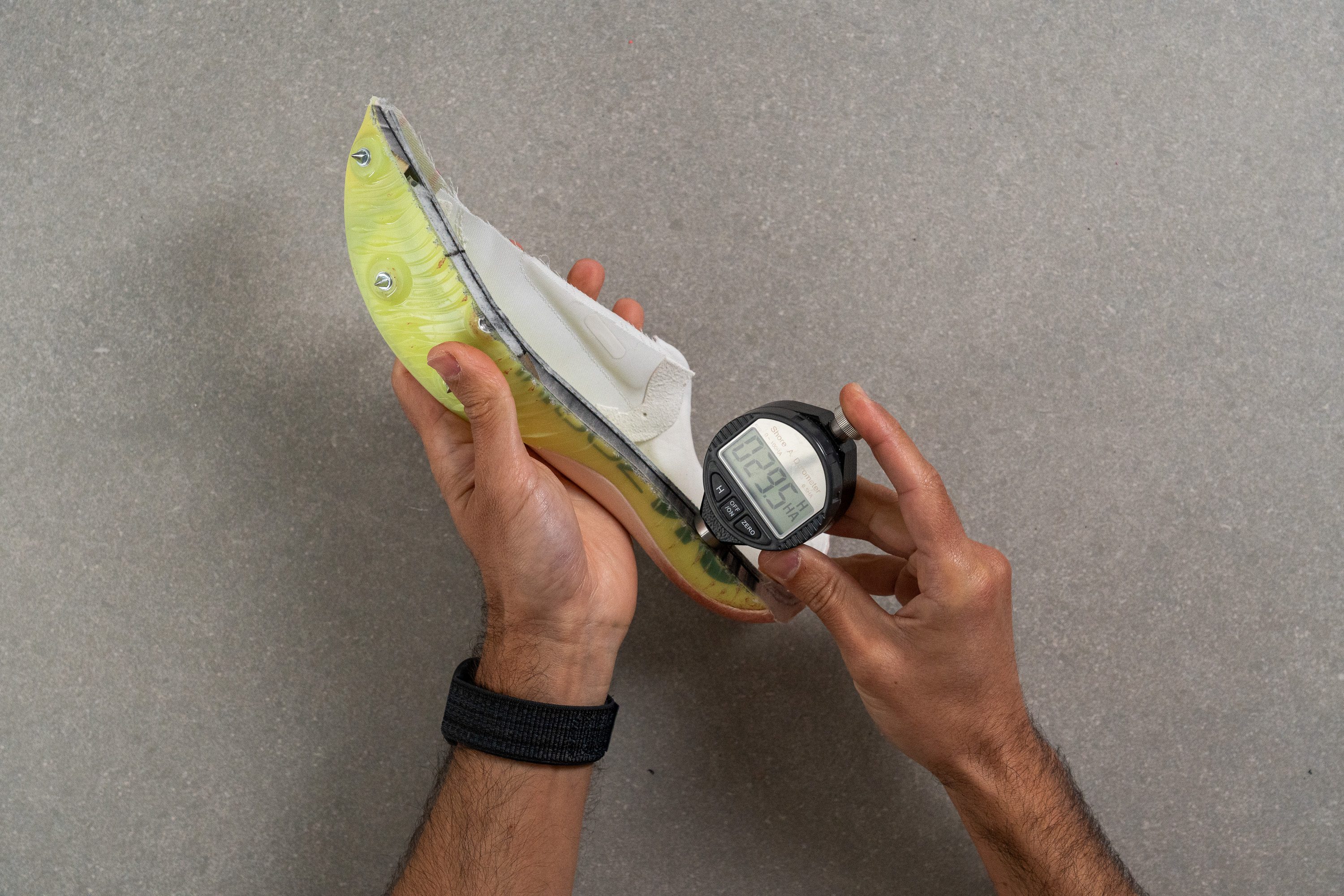
| Air Zoom Maxfly | 29.0 HA |
| Average | 24.3 HA |
Flyplate
In top-tier track spikes, optimal speed demands one key feature, a carbon plate. The Maxfly delivers with Nike's renowned Flyplate technology, which is a full-length carbon plate positioned strategically above the foam and Air Zoom unit. With each step, this setup maximizes compression for explosive energy return.
Just be prepared—unlike simpler foam-based spikes, the Flyplate creates a noticeably stiff and aggressive ride no matter the distance.
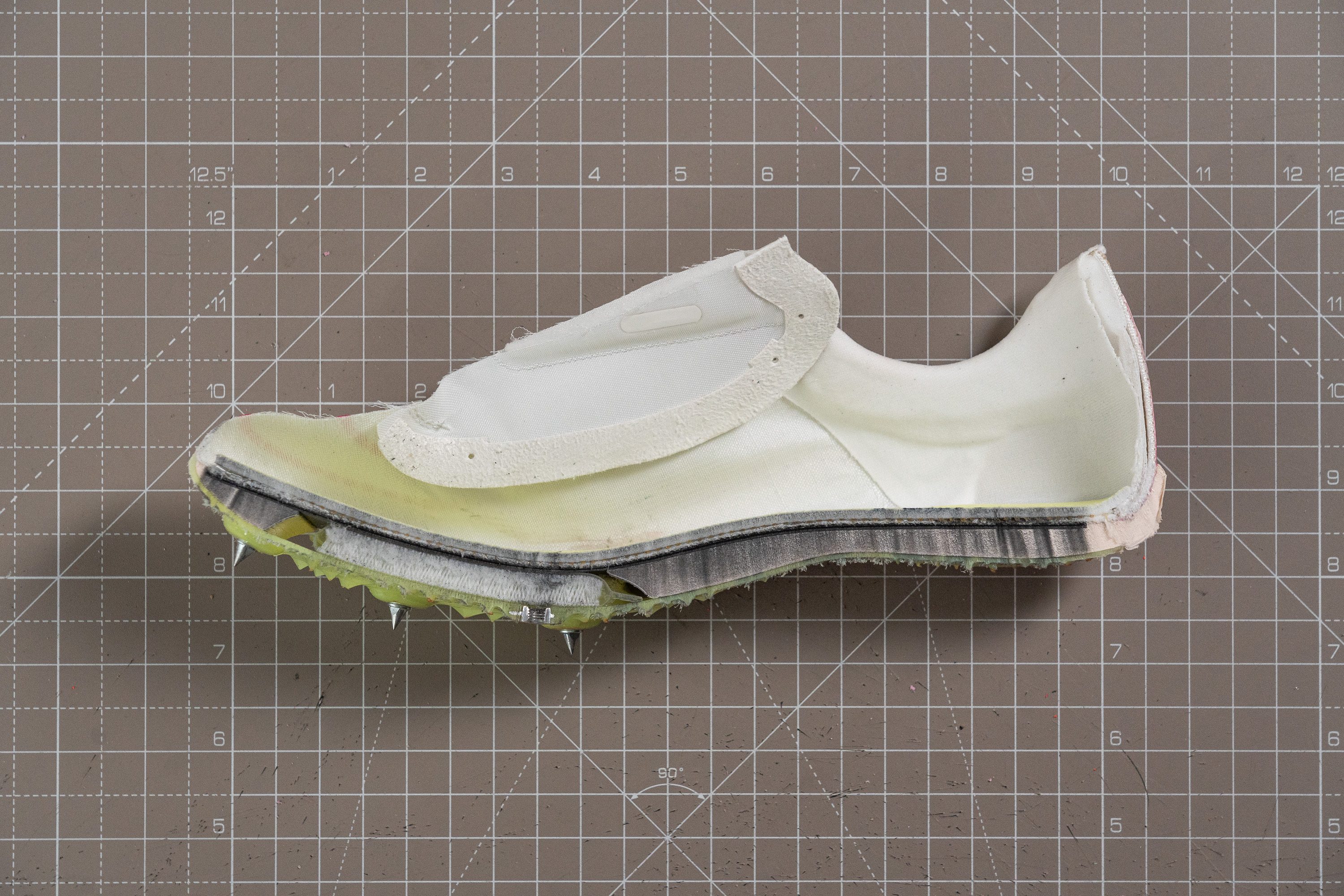
Air Zoom
Besides its ZoomX foam and Flyplate, the star of the midsole is a big Air Zoom unit. Although it offers great metatarsal protection, we think that its unique ride might not suit runners who crave a classic ground feel.
This unit evokes us those found in Nike shoes like the Pegasus 40, yet it's dialed up in size and width for the ultimate in energy return and forefoot cushioning.
Size and fit
Size
Nike Air Zoom Maxfly fits slightly small (90 votes).
Toebox width - widest part
With minimal vertical space in the toebox, we discovered that the design prioritizes an ultra-snug, race-ready lockdown to efficiently channel power down into the track.
However, width-wise, things expand somewhat—our measurements showed 87.3 mm at the upper's widest point, which is decently roomy for this kind of spike.
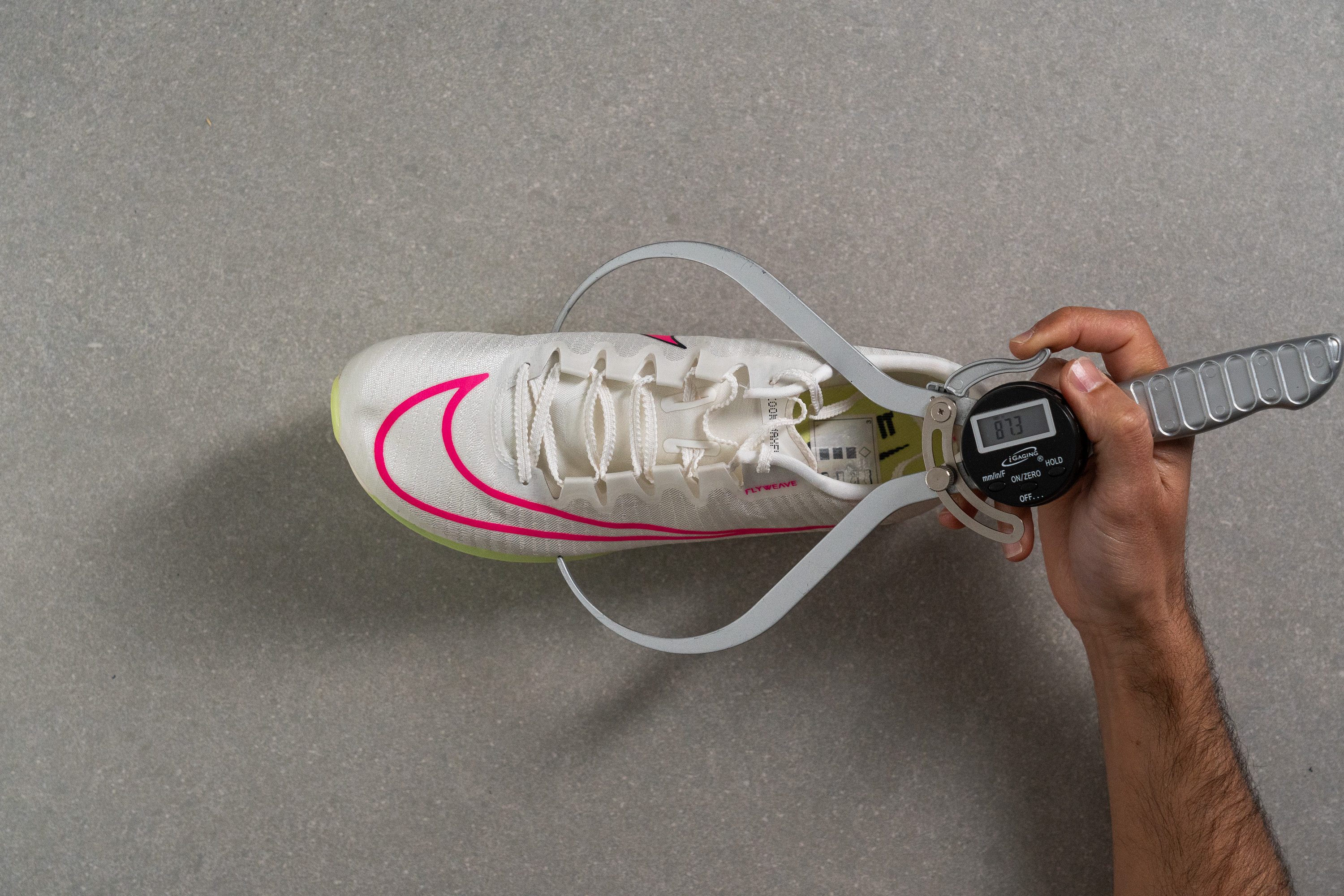
This test follows an older methodology, which is why you don't see recently tested shoes in the chart. Results from different methodologies can not be compared.
| Air Zoom Maxfly | 87.3 mm |
| Average | 88.9 mm |
Toebox width - big toe
While the Maxfly prioritizes a performance-driven, streamlined fit, the big toe area boasts a surprisingly generous width. Thanks to this less aggressive taper than many track spikes.
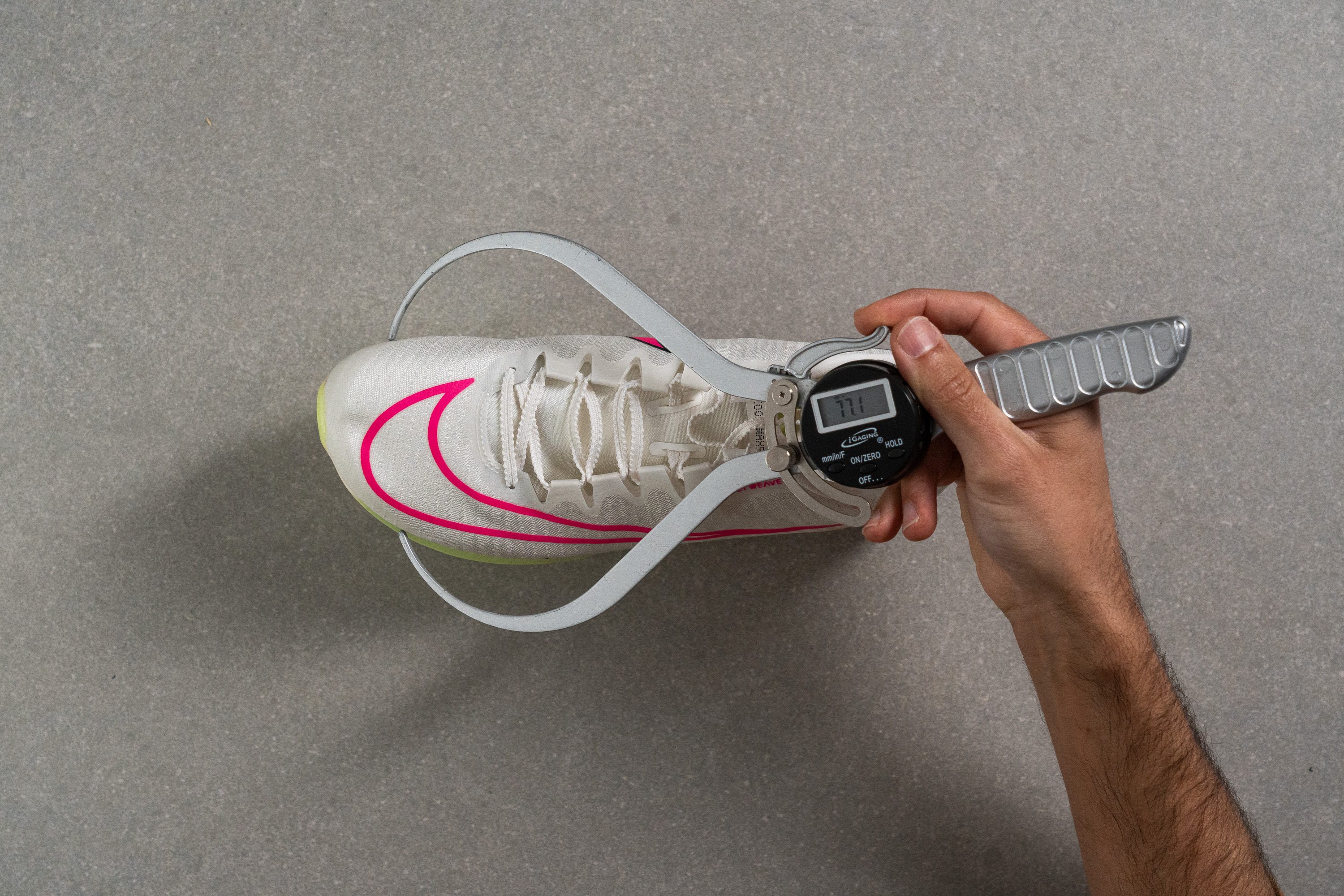
This test follows an older methodology, which is why you don't see recently tested shoes in the chart. Results from different methodologies can not be compared.
| Air Zoom Maxfly | 77.1 mm |
| Average | 73.7 mm |
Removable pins
The Maxfly boasts a 7-pin setup in the forefoot area, and you can effortlessly remove these pins whenever needed.
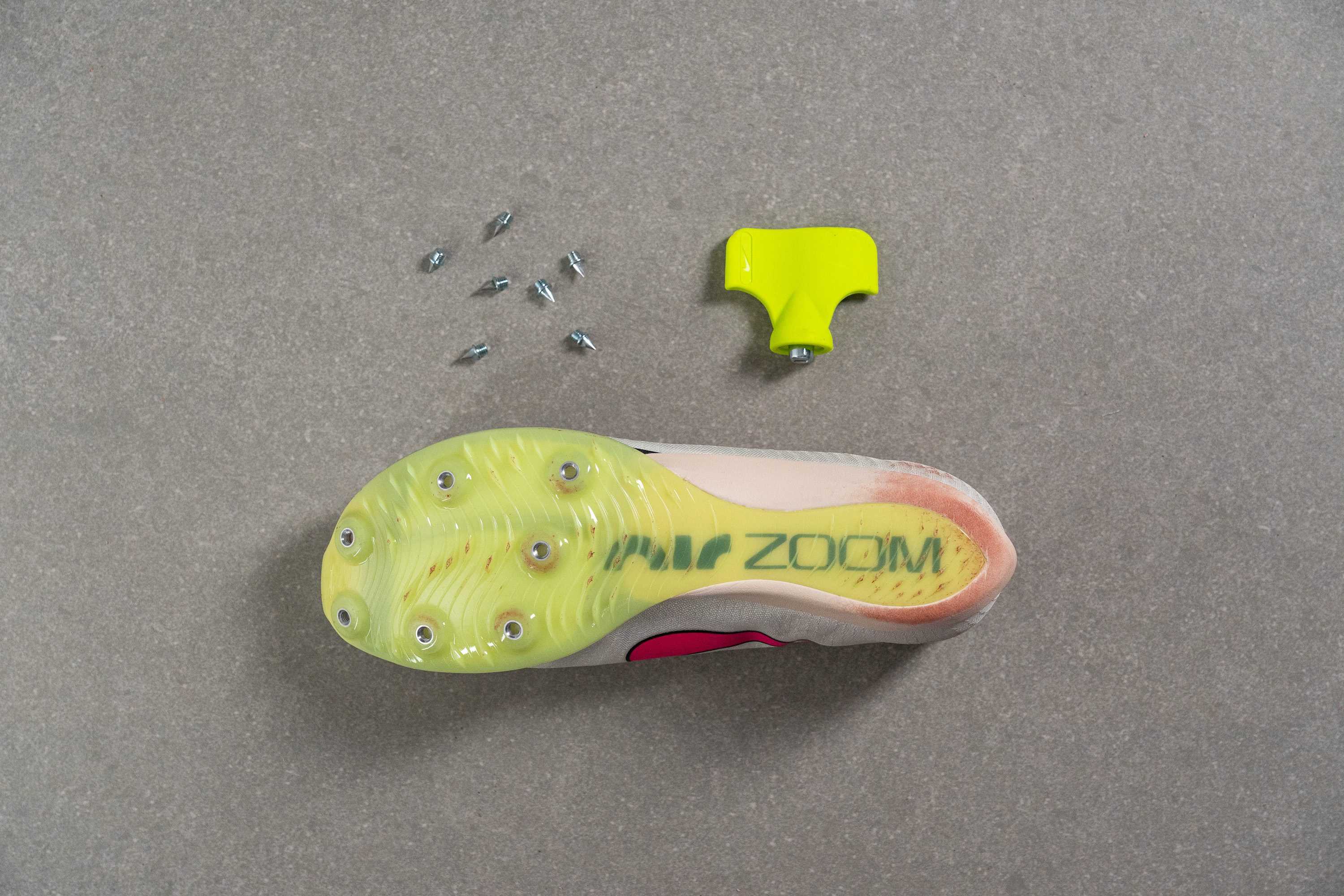
Flexibility / Stiffness
From the moment we slipped on the Maxfly, we immediately noticed its stiff ride—undeniably due to the carbon-fiber plate embedded within.
Yet, we're keen on backing our sensations with solid data. That led us to conduct our 30-degree bend test. The results were telling, as we encountered a sky-high 20.5N of resistance against our machine, confirming the Maxfly's exceptionally stiff and responsive nature.
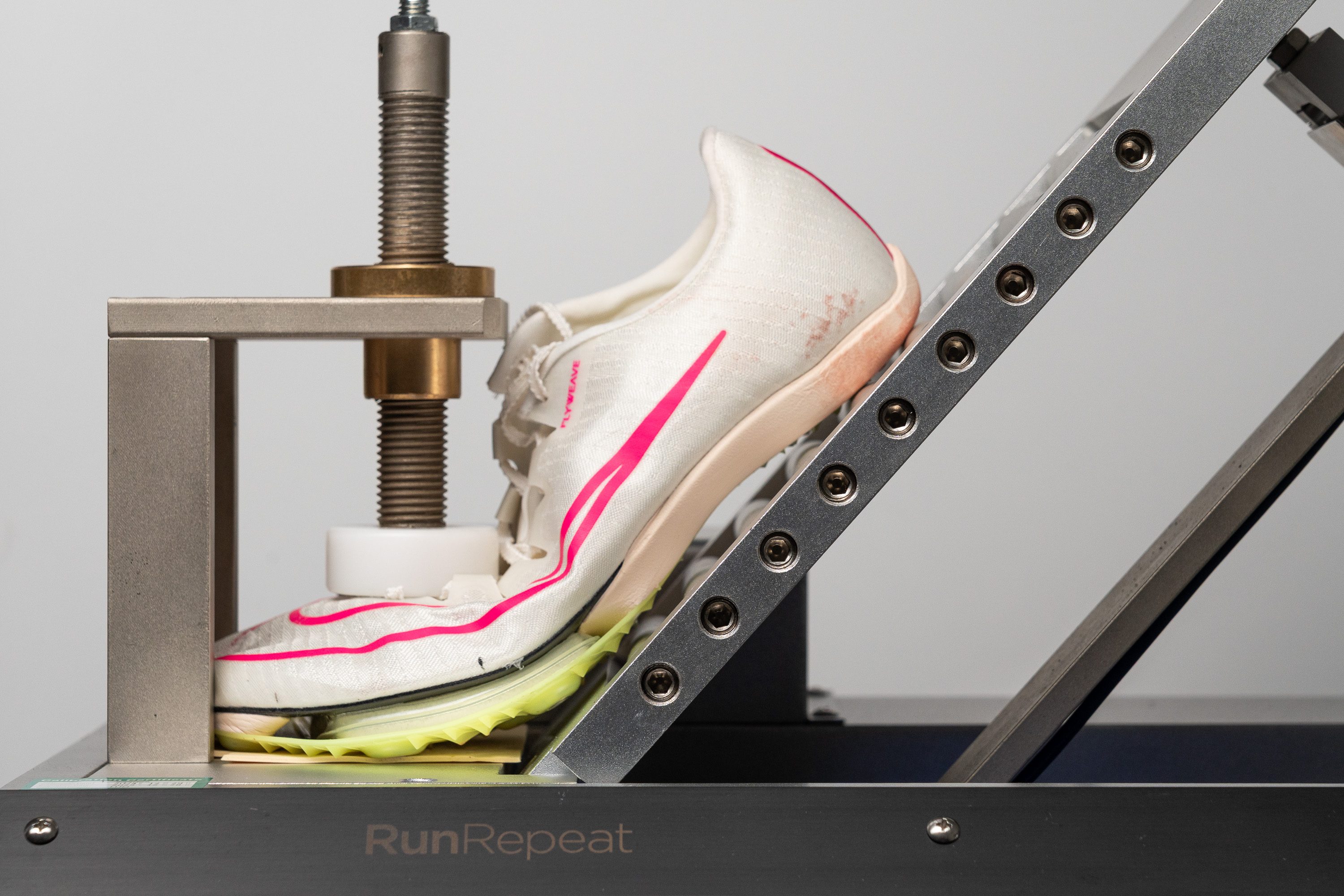
| Air Zoom Maxfly | 20.5N |
| Average | 13.0N |
Weight
Weighing in at 6.0 oz (169g), the Maxfly falls short compared to other aspects of its design.
It's certainly not a heavy spike, but Nike has set the bar high, and this weight closely mirrors the Vaporfly 3, which has twice the stack height of the Maxfly.
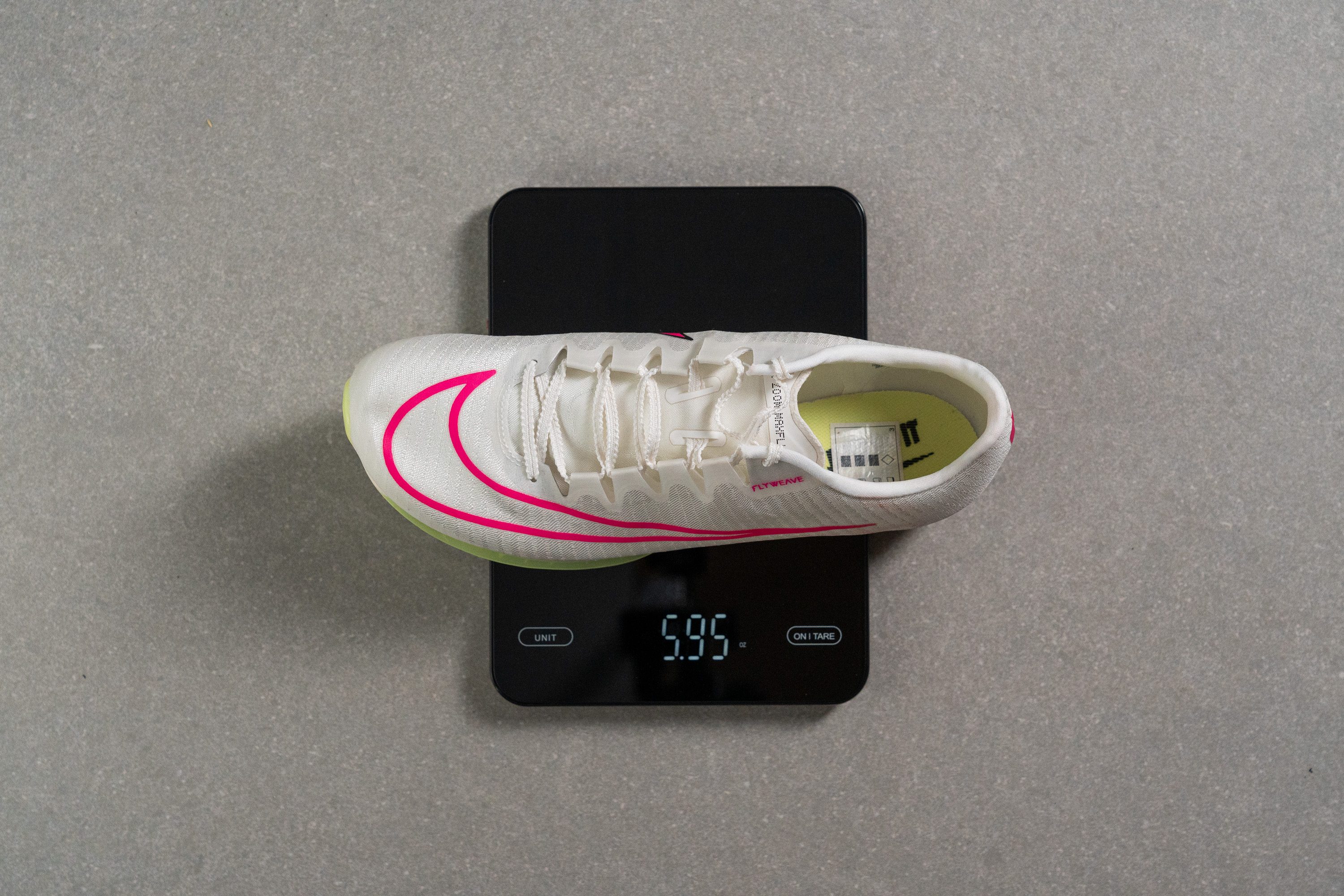
| Air Zoom Maxfly | 6.0 oz (169g) |
| Average | 5.5 oz (156g) |
Breathability
Though breathability may not top the priority list for track spikes designed for explosive sprints, some ventilation helps, especially during longer training sessions in summer. We were pleasantly surprised by the Maxfly's average-at-best performance in our smoke-pumping test.
This surprised us, as sprint spikes prioritize an exceptionally lightweight build, and super-light uppers typically score an easy 5/5 for breathability. The Maxfly landed a respectable 3/5, though.
Shedding more light on the situation (pun intended!), we discovered a dense Flyweave mesh. This feature improves support and stability.
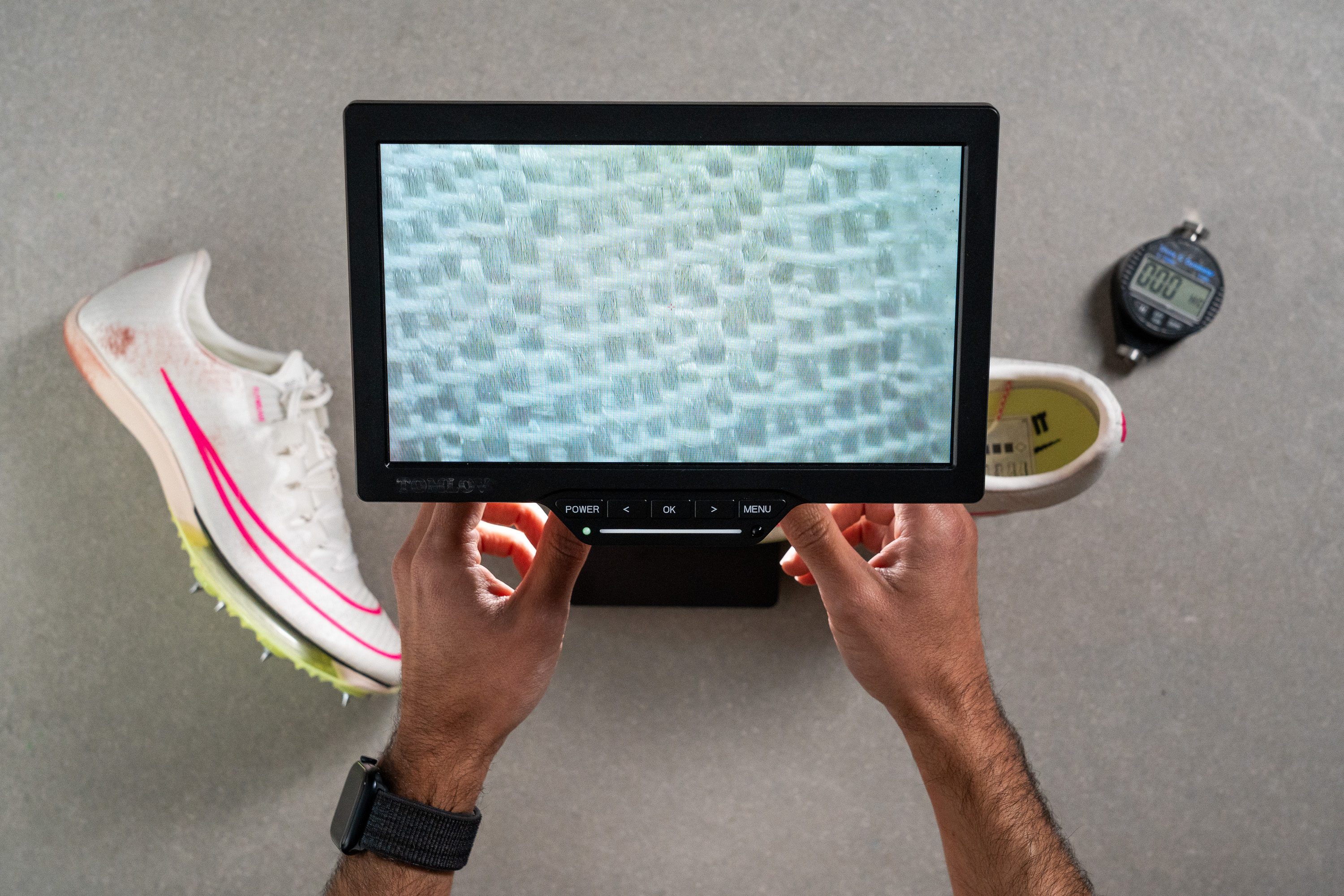
Our microscope offered the ultimate proof. There's not a single ventilation hole or gap in the tightly woven mesh.

Finally, we took a detailed look at the upper and found surprisingly plush padding for such a sprint-focused spike, especially in the heel area.
Runners who are prone to discomfort in this region will deeply appreciate this design choice.
| Air Zoom Maxfly | 3 |
| Average | 4 |
Stability
Torsional rigidity
Despite that carbon plate, the Maxfly retains a surprising degree of flexibility, earning a respectable 4/5 on our rigidity test.
This welcome bend gives it a more forgiving feel compared to some ultra-rigid spikes.
| Air Zoom Maxfly | 4 |
| Average | 3.2 |
Heel counter stiffness
To ensure a secure fit when accelerating into full-speed sprints, the Maxfly's heel counter boasts some structure. We found that this added support provides excellent heel lockdown—crucial for maximizing power with every stride.
| Air Zoom Maxfly | 3 |
| Average | 1.6 |
Midsole width - forefoot
Now for midsole measurements! Given the Maxfly is engineered for blazing-fast 60m to 400m sprints (with even some 800m/mile runners opting for it), a streamlined design seemed inevitable in the forefoot. And with our digital caliper measuring a lean 93.9mm, our expectations were fully confirmed.
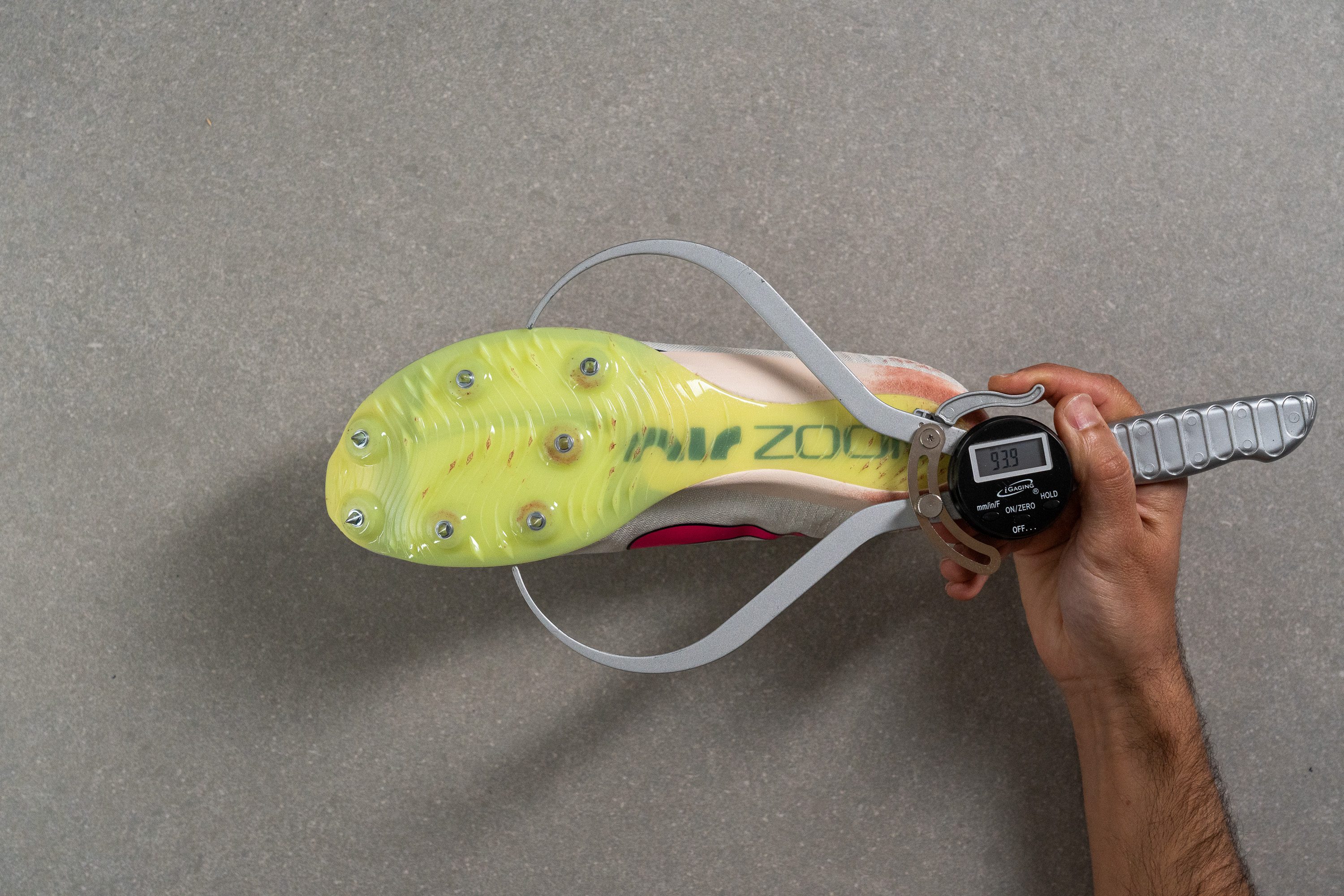
| Air Zoom Maxfly | 93.9 mm |
| Average | 94.4 mm |
Midsole width - heel
As with the forefoot, the MaxFly boasts a remarkably narrow heel—just 59.2mm according to our digital calipers.
But remember, we're talking about a sprint-focused shoe here. This design keeps feet locked in for pure performance. This is more a Ferrari than an Audi A8!
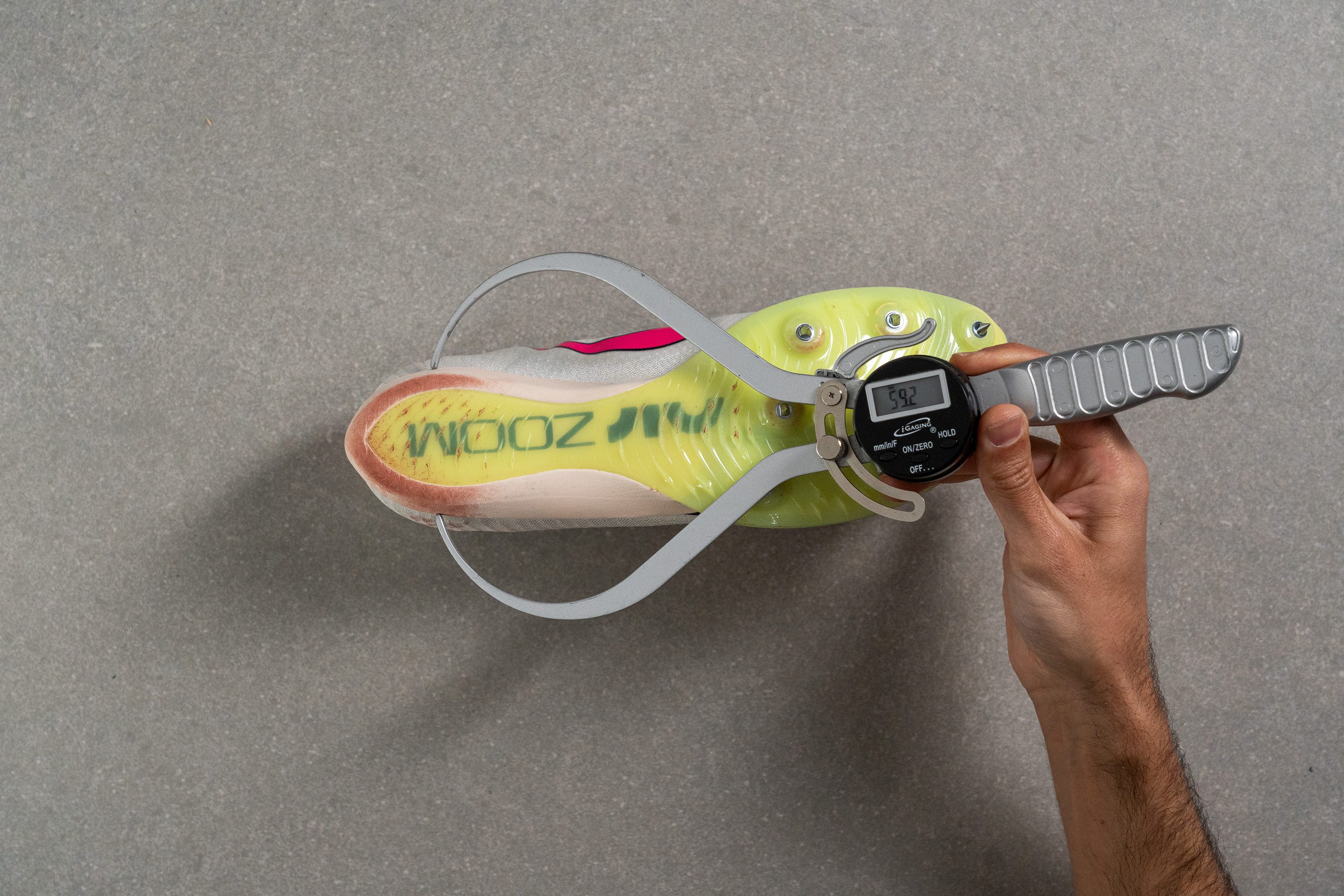
| Air Zoom Maxfly | 59.2 mm |
| Average | 62.3 mm |
Durability
Toebox durability
Now comes the moment of truth—testing upper durability with our Dremel. You might think wear and tear doesn't matter much with sprint spikes, but big toe nails have been known to rip open those flimsy uppers really quickly!
Thankfully, the Maxfly held its own during our Dremel test, earning a strong 3/5 score. This indicates enough toughness to withstand the rigors of its intended lifespan.
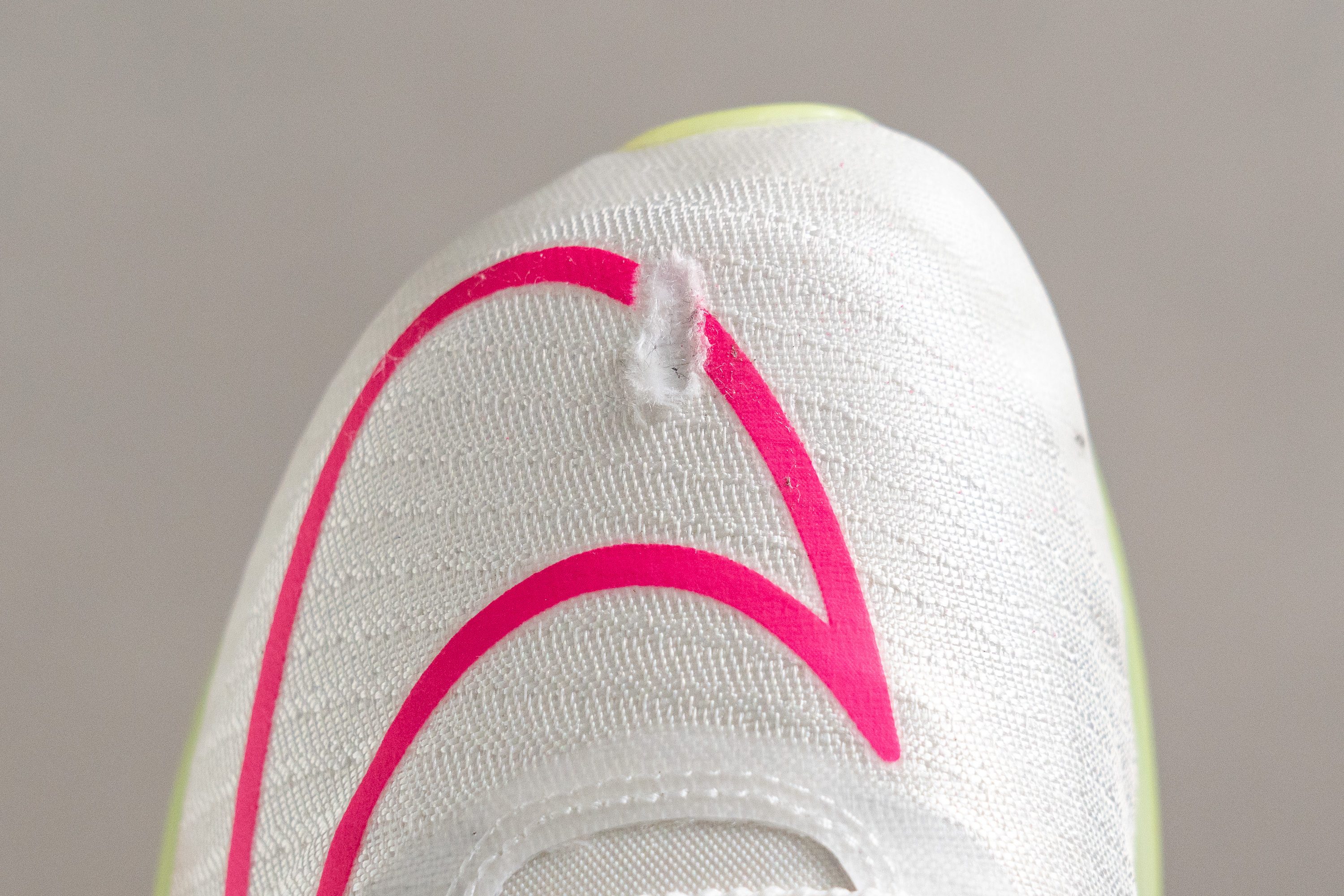
| Air Zoom Maxfly | 3 |
| Average | 2.3 |
Heel padding durability
In the heel area, the MaxFly truly shined, demonstrating impressive resistance to wear and tear.
We gave it a flawless 5-out-of-5 score! With durability like this, runners can trust that the heel will remain intact for years.
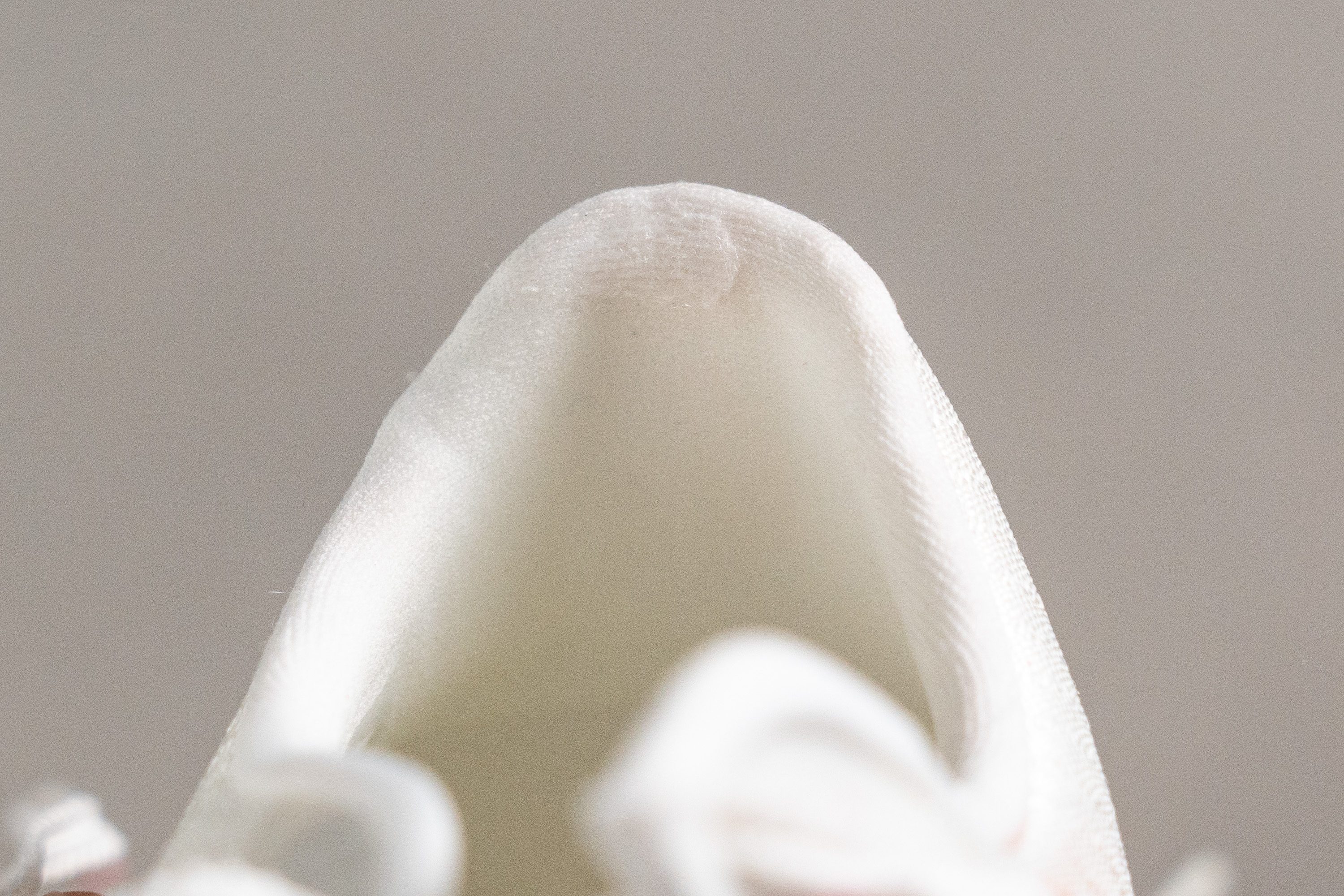
| Air Zoom Maxfly | 5 |
| Average | 3.5 |
Outsole thickness
Our measurement revealed an outsole thickness of 1.9 mm.
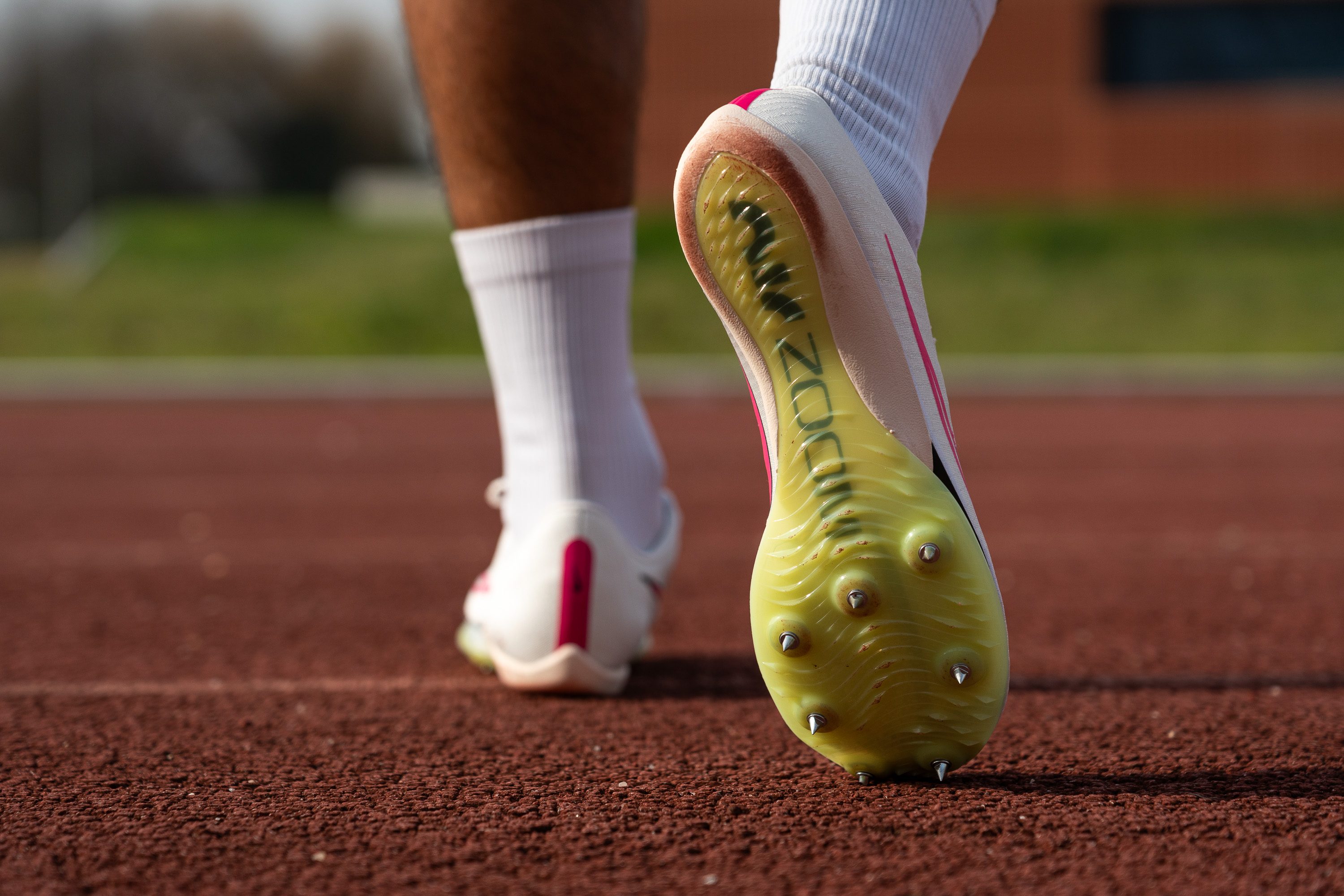
Notably, its strategic placement allows for added traction and responsiveness in the forefoot while dipping below the foam in the heel, prioritizing greater cushioning and impact absorption.

| Air Zoom Maxfly | 1.9 mm |
| Average | 2.7 mm |
Misc
Insole thickness
As is standard in track spikes, the Maxfly keeps things minimal with a thin 2.8 mm insole. This lean design ensures a close, direct connection to the midsole.
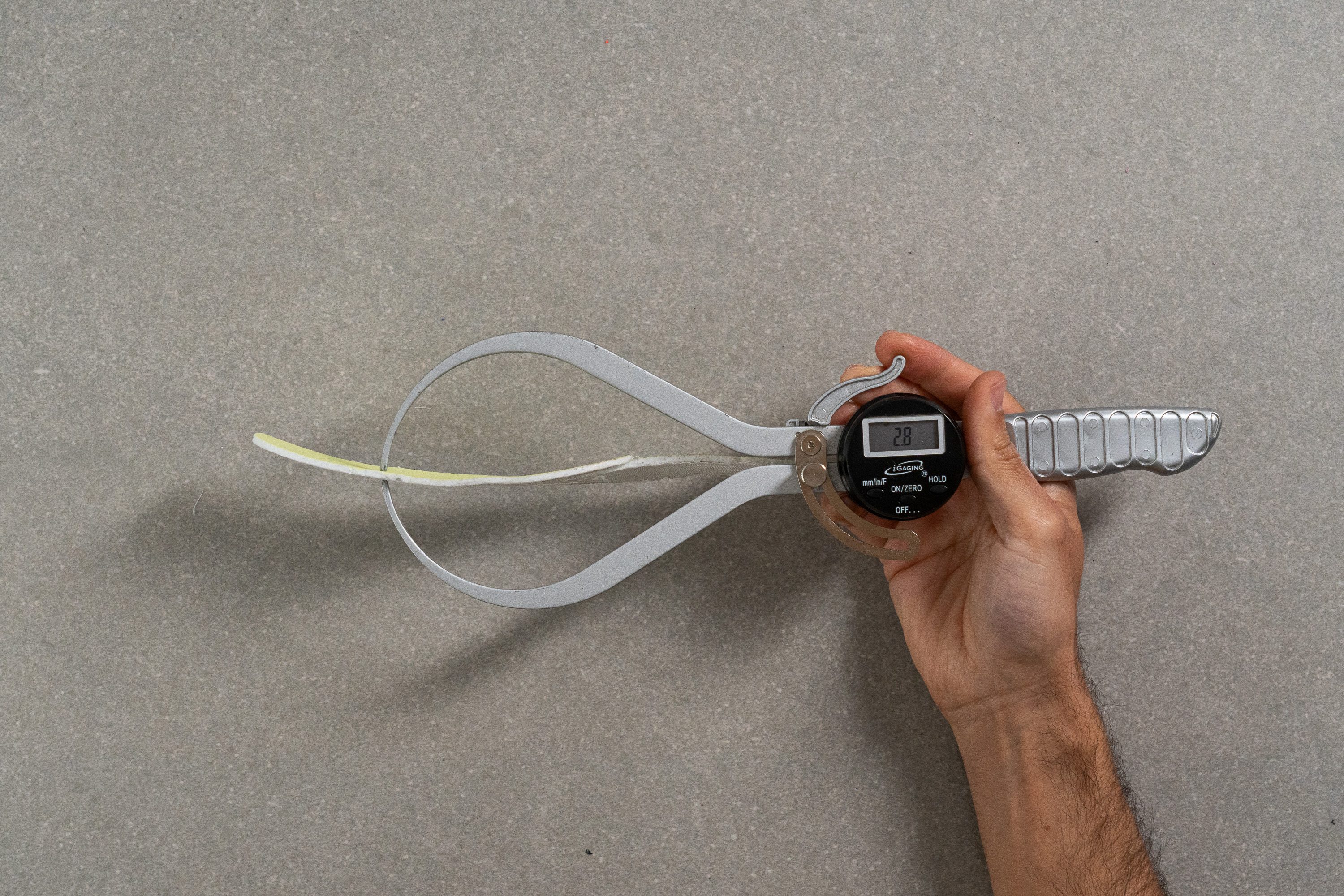
| Air Zoom Maxfly | 2.8 mm |
| Average | 2.9 mm |
Tongue padding
The tongue boasts impressive padding for a sprint track spike—we measured it at 3.9 mm, which is thicker than many road racing shoes.
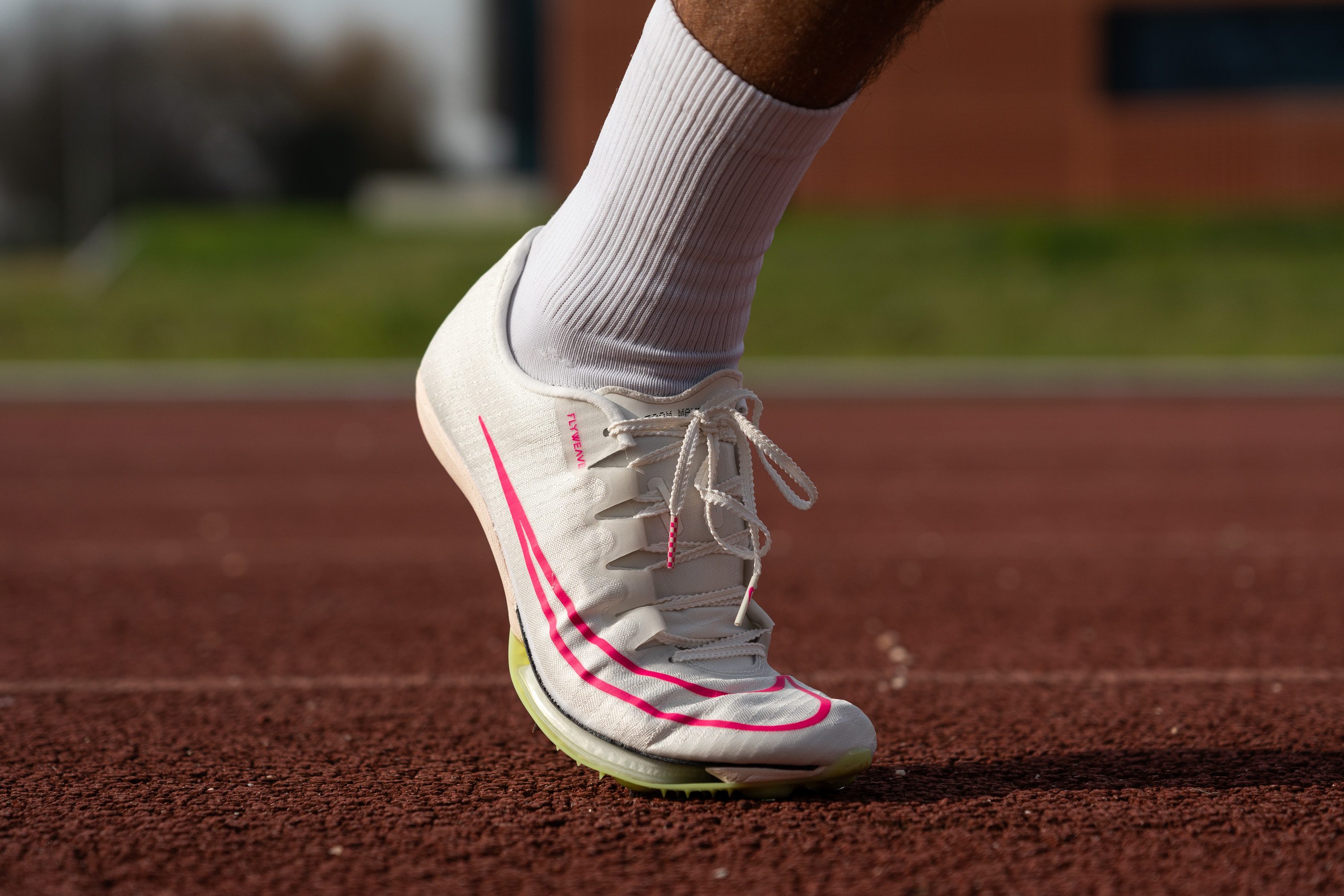
In fact, we believe Nike could slightly trim down the tongue in the next version to reduce weight.
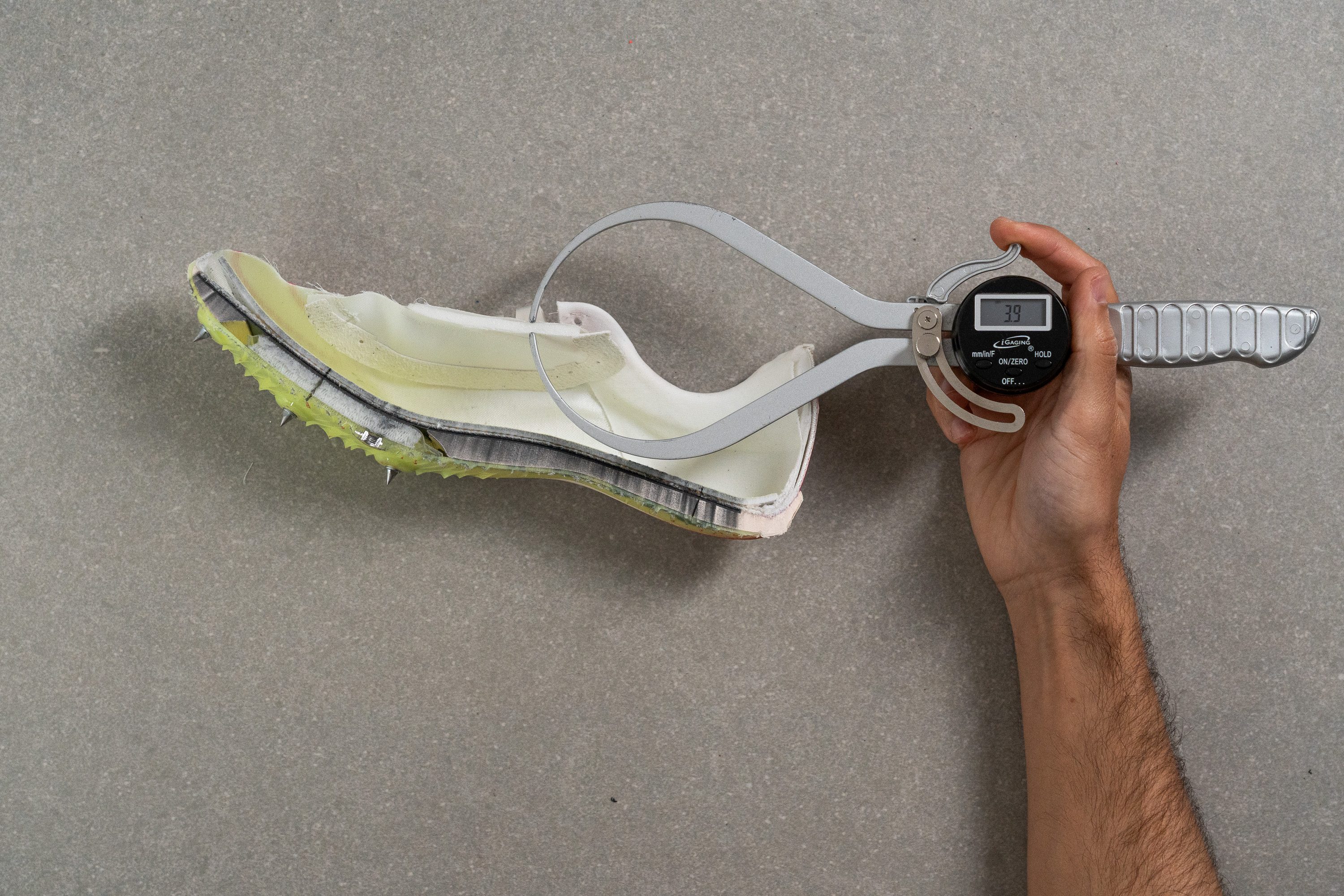
| Air Zoom Maxfly | 3.9 mm |
| Average | 2.4 mm |
Heel tab
We didn't find a heel tab on the Maxfly, although we weren't expecting one either.
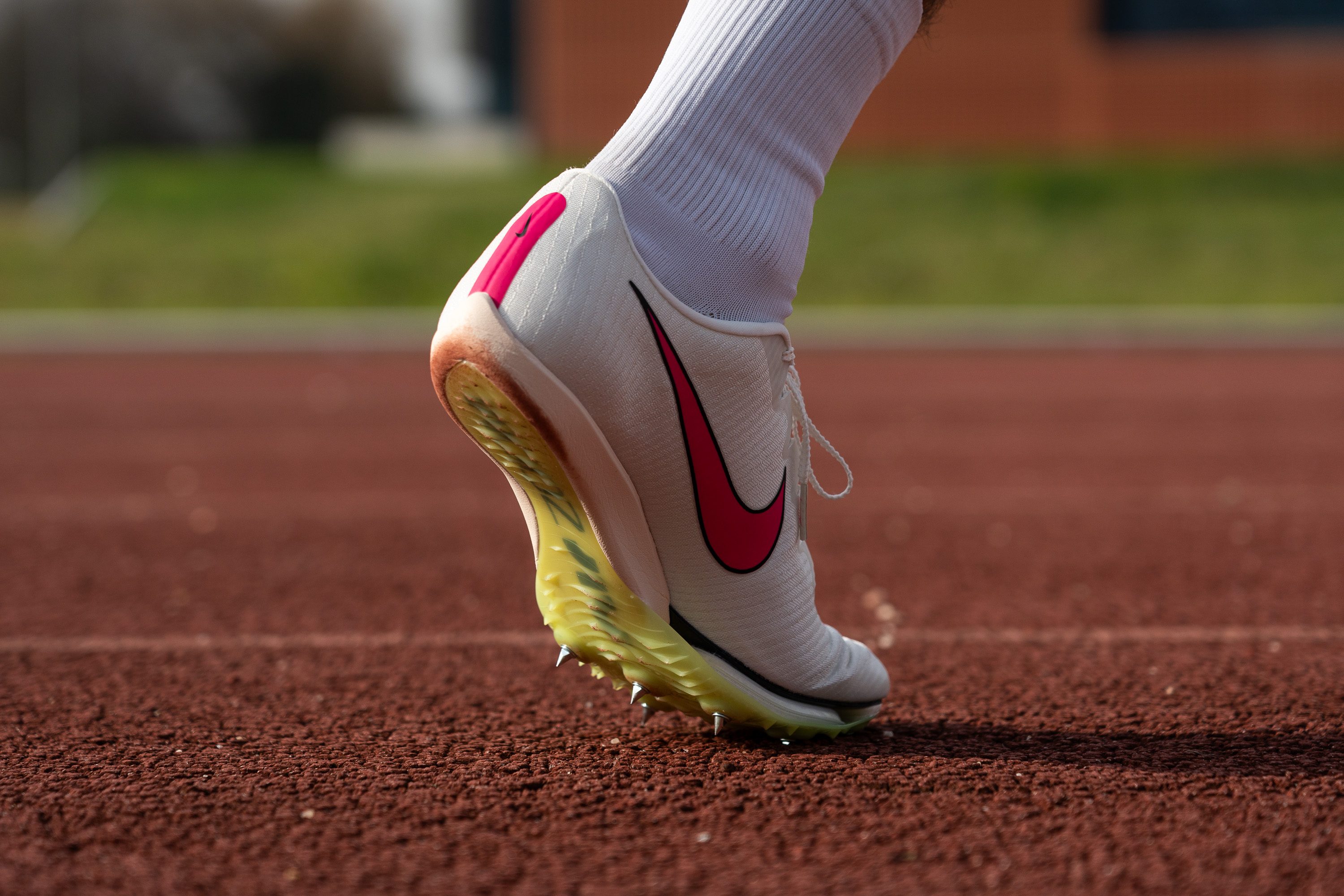
| Air Zoom Maxfly | None |

